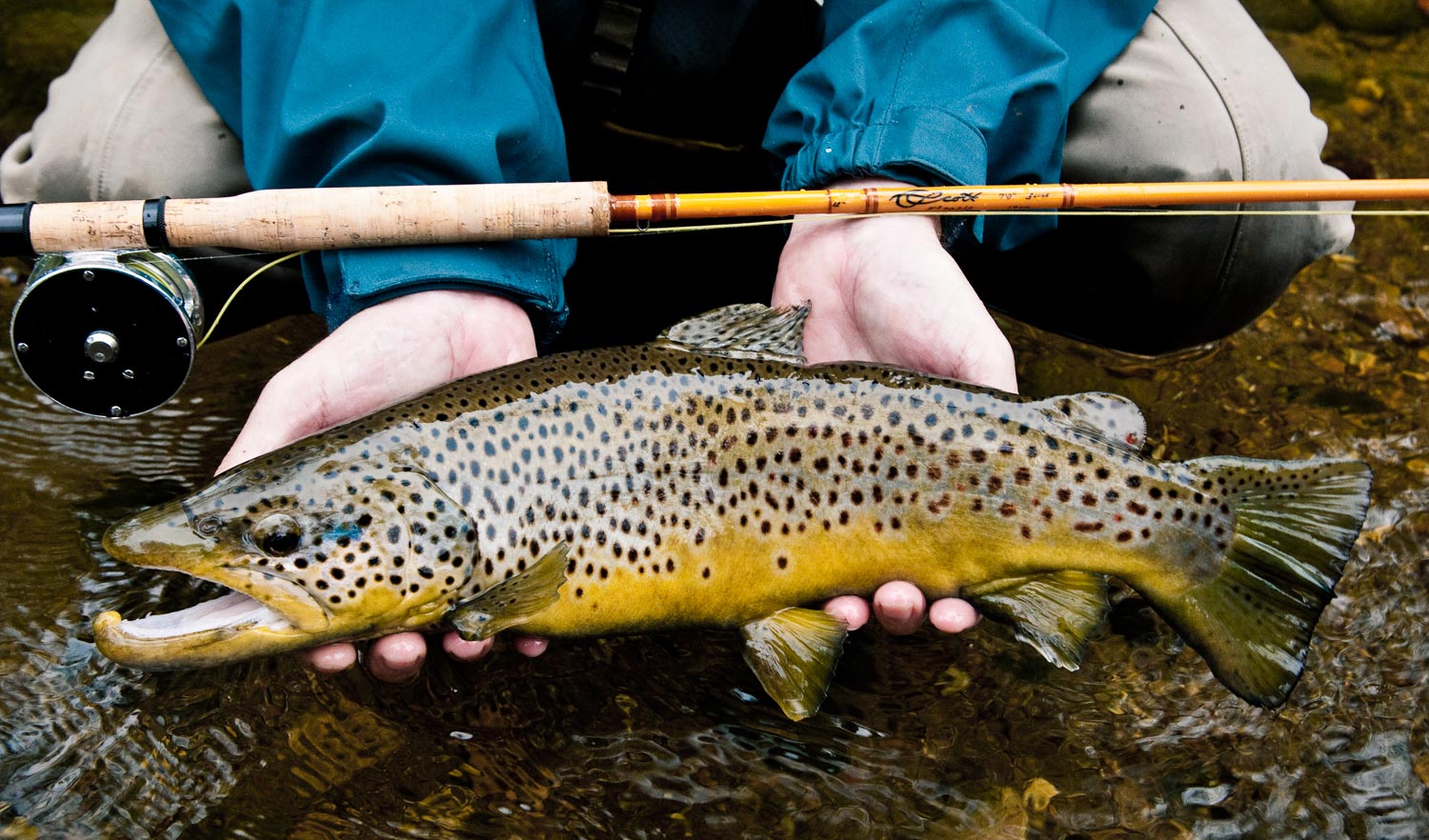By Louis Cahill
When choosing between graphite and fiberglass fly rods, it’s smart to consider where and how you fish.
I got an email the other day from a reader. Here’s an excerpt:
“I am looking at a 7wt predominantly for trout and smallmouth here in Tennessee. I currently have a mid action 6wt that is really nice, but since I don’t have a boat, it’s hard to make long casts with weighted streamers to trout on the opposite bank. I recently found the blue halo 7wt glass rods, and I guess my question is how do you feel about fiberglass streamer rods? Do they have the muscle to turn over the same weighted streamers a graphite 7wt would have?”
It’s a great question. There’s a lot of enthusiasm right now for heavyweight fiberglass fly rods. I have one myself and I enjoy fishing it very much. Does that mean it’s the best tool for the job? Not necessarily. If, like the fellow who emailed me, I was mainly concerned with casting a heavy fly to the far bank, it’s probably not the rod I’d choose.
I like fiberglass rods a lot. I have glass single-handers in weights from 2-8, and a one spey. There are some things they are very good at, and some things they are not. You can make a long cast with a heavy fly using a glass rod but you’ll have to be a great caster.
When you are deciding between glass and graphite, consider the strengths of each.
Strengths of fiberglass fly rods
Feel: Fiberglass rods have great feel, which means that it’s easier to feel the rod load. The feedback which the caster receives from the rod makes casting very pleasant for anglers who enjoy feel.
Tempo: Glass rods are slow. That’s both an asset and a liability but the slower casting tempo which comes with a slower rod is easier in many ways. If you were trying to play a complicated piece of music, wouldn’t it be easier to play it slowly?
Presentation: Because they do not generate the line speed graphite rods do, glass rods lend themselves to delicate presentations. Remember, however, that presentation is about casting skill and material alone is not the answer.
Strength: Not strength as in casting power, but toughness. Glass rods are hard to break. The fibers stretch much more than graphite fibers so the rod will bend much deeper without breaking. They are also much less likely to be damaged by physical blows.
Load: Because of the flexible nature of fiberglass and the actual weight of the material, many fiberglass rods literally load themselves. That means they will make a nice loop with little or no line out of the tip-top. Perfect for small streams.
Gentleness: Because a glass rod flexes so readily, it is very gentle on your tippet. Even big fish will have a hard time breaking light tippet on a fiberglass rod.
Affordability: Glass rods are on the whole much less expensive than graphite, largely because the material itself is much cheaper.
Fun: Admittedly this is silly, but many anglers just enjoy fishing fiberglass rods. Maybe it’s because you feel the load, or because they bend to the cork with a fish on, because they glow in the sunlight or just because it’s nostalgic. Whatever the reason, fun is a word that always comes up when you talk with glass-heads.
Limitations of fiberglass
Line Speed: Slow rods mean slow line speed. Glass rods struggle in the wind and don’t lend themselves to distance casting. They will also have a harder time with large, wind-resistant flies.
Weight: One of the biggest drawbacks of fiberglass is its weight, especially in higher line weights and longer rods. This is one of the main reasons I don’t recommend them for streamer fishing. Casting fatigue is not just unpleasant, it makes you fish poorly.
Ok, lots of good reasons there to fish with fiberglass rods.
Especially for trout anglers. In smaller weights, for general trout fishing and especially small stream fishing, glass rods are hard to beat. If you’re using them for streamer fishing or saltwater, maybe you’re doing it the hard way, but who cares if you’re having fun. Before you click the buy button, let’s have a look at what a graphite rod can do for you.
Strengths of graphite rods
Power: A fly rod amplifies energy from your hand and stores it in the fly line. As of today, we have no more efficient material for doing that than graphite. Power means line speed to cut the wind, casting distance when you need it, and the energy to cast heavy flies and sinking lines.
Recovery Rate: The speed at which the rod returned to from a flexed position to straight. Recovery rate is is what determines if a rod is fast or slow. A fast recovery rate does some pretty impressive things, but at the top of that list would be throwing tight loops. Tight loops cut the wind, increase distance and accuracy and put flies deep under overhanging vegetation.
Authority: The stiffness of graphite allows for a rod with a stiff butt section for fighting tough fish. Landing fish quicker means landing more fish and, in general, landing them in better condition.
Weight: Graphite is extremely light. In addition to enhancing casting performance this makes graphite the perfect material for rods of higher line weights and greater lengths.
Multi-Modulus Design: Graphite is a very sophisticated material and is available in countless varieties of both fiber and resin. This variety of materials allows rod designers to layer and blend materials to create unique properties. They can use these materials in different ways to give each section of a rod the qualities needed for the rod to perform as needed. Almost all graphite rods also incorporate fiberglass for strength.
Limitations of graphite
Delicacy: Graphite itself is actually very strong, but graphite rods are hotrods. Rod designers push the capabilities of the material to produce high performance rods. These rods are usually prone to physical damage and can even break by being bent too deeply in their finer sections. It’s certainly not a deal breaker. You just need to pay attention to how you handle your rods.
$$$: Graphite is extremely expensive, especially the newest, latest, high-tech materials. This means that high-performance graphite rode are by nature more expensive. This is likely not news to anyone.
So there you have it. Some pretty good reasons to fish graphite rods as well.
I guess it’s no surprise that many of us end up owning both graphite and fiberglass fly rods. Luckily, there’s no wrong choice, but before you choose, it’s worth taking a minute to think about the kind of fishing you’ll be doing and choose a rod whose natural strengths will set you up for success.
Louis Cahill Gink & Gasoline www.ginkandgasoline.com hookups@ginkandgasoline.com Sign Up For Our Weekly Newsletter!
Sign Up For Our Weekly Newsletter!




Thanks for sharing a balanced, fact based comparison. I think your last point, fun factor, is honestly the most important regardless of rod material, brand or action. My first fly rod was a hand-me-down glass rod from my dad. As I became a more advanced fisherman and had more $ to spend I moved to graphite. Over the years I’ve owned and fished lots of great rods from most of the big name companies. About 3 years ago on a bit of a whim I picked up a glass rod and fell in love. I now fish iglass exclusively. Now, my fishing is in Western NC on smaller streams and rivers, not big, windy, open country like out west, but most of the time I feel I don’t give up too much. Is it the most efficient for streamers; nope. Nymphing; nope. Long casts in wind; nope. Despite slight limitations in these areas I simply prefer glass because to.me it’s just more fun. I’m a recreational fisherman and the soulful simplicity of a glass rod and click & pawl reel really hits the spot for the limited time I get to get out and fish. Life in the slow lane for me I guess!
Might add great to roll cast and great for light tip protection in the pros column too.
That’s easily the best, get to the point, evaluation of glass and graphite. You don’t need any further information on the subject.
Pingback: Tippets: Dry Fly Fishing in Stillwaters, Montana Wildfires, Glass vs. Graphite - Pesca y Bits
One thing I would add to the pros/cons is that most glass rods, because of their “slower” action are much more prone to missing hookups when casting at distance. The flexibility creates an additional shock-absorber action that while great for fighting fish and protecting tippets, adds to the amount of slack in the system when setting the hook. For sure this can be overcome by using a strip set, but you really need to be on top of your game when you have a lot of line out.
Im going back to glass rods. Over the past several years I have had 5 graphine rods break during normal light use. Something is different about their construction. I do not buy custom rods made especially for me, I cannot afford it. I still have a dozen rods of all genre from about 10 yeas ago or more and they hold up just fine. I have had two spinning rods break during hook setting, one broke in three pieces. Until there is a mojor change in construction, Im sticking with the glass.
Glass is ass.
I have used glass rods for a time and really like them when you can do a normal cast. Great feel. My problem with glass rods comes when you are on a very small stream or when your backcast is hampered. These improvised casts are not accurate for me because the tip is so flexible. I find a graphite rod with a more stable (but stiffer) tip more accurate.
Pingback: Glass or Graphite? | MidCurrent
Pingback: Glass or Graphite? – BestFitnessDirect
Pingback: Louis Cahill”s View on Glass or Graphite? – My Outdoors Supplies